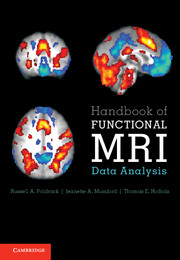Crossref Citations
This Book has been
cited by the following publications. This list is generated based on data provided by Crossref.
Frydman, Cary
Barberis, Nicholas
Camerer, Colin F.
Bossaerts, Peter L.
and
Rangel, Antonio
2011.
Testing Theories of Investor Behavior Using Neural Data.
SSRN Electronic Journal,
Lazar, Nicole
2012.
The Big Picture: Functional Magnetic Resonance Imaging—Introduction to a Neuroimaging Modality.
CHANCE,
Vol. 25,
Issue. 4,
p.
42.
Pongpanitanont, Pongphan
Sittiprapaporn, Wichian
and
Charoensuk, Warakorn
2012.
Effect of musical tones in auditory perception analysis using nonlinear model.
p.
1.
Minas, Giorgos
Rigat, Fabio
Nichols, Thomas E.
Aston, John A.D.
and
Stallard, Nigel
2012.
A hybrid procedure for detecting global treatment effects in multivariate clinical trials: theory and applications to fMRI studies.
Statistics in Medicine,
Vol. 31,
Issue. 3,
p.
253.
Stice, Eric
and
Burger, Kyle S
2012.
Encyclopedia of Life Sciences.
Chou, Chun-An
Kampa, Kittipat “Bot”
Mehta, Sonya H.
Tungaraza, Rosalia F.
Chaovalitwongse, W. Art
and
Grabowski, Thomas J.
2012.
Brain Informatics.
Vol. 7670,
Issue. ,
p.
196.
Glover, Gary H.
Mueller, Bryon A.
Turner, Jessica A.
van Erp, Theo G.M.
Liu, Thomas T.
Greve, Douglas N.
Voyvodic, James T.
Rasmussen, Jerod
Brown, Gregory G.
Keator, David B.
Calhoun, Vince D.
Lee, Hyo Jong
Ford, Judith M.
Mathalon, Daniel H.
Diaz, Michele
O'Leary, Daniel S.
Gadde, Syam
Preda, Adrian
Lim, Kelvin O.
Wible, Cynthia G.
Stern, Hal S.
Belger, Aysenil
McCarthy, Gregory
Ozyurt, Burak
and
Potkin, Steven G.
2012.
Function biomedical informatics research network recommendations for prospective multicenter functional MRI studies.
Journal of Magnetic Resonance Imaging,
Vol. 36,
Issue. 1,
p.
39.
Velasquez, J. J.
Suarez, X.
Aristizabal, I.
Ascencio, J.
and
Ochoa, J.
2013.
Functional connectivity changes caused by multiple sclerosis.
p.
1.
Reuter-Lorenz, Patricia A.
and
Cimprich, Bernadine
2013.
Cognitive function and breast cancer: promise and potential insights from functional brain imaging.
Breast Cancer Research and Treatment,
Vol. 137,
Issue. 1,
p.
33.
Welvaert, Marijke
Tabelow, Karsten
Seurinck, Ruth
and
Rosseel, Yves
2013.
Adaptive Smoothing as Inference Strategy.
Neuroinformatics,
Vol. 11,
Issue. 4,
p.
435.
Takemi, Mitsuaki
Masakado, Yoshihisa
Liu, Meigen
and
Ushiba, Junichi
2013.
Event-related desynchronization reflects downregulation of intracortical inhibition in human primary motor cortex.
Journal of Neurophysiology,
Vol. 110,
Issue. 5,
p.
1158.
Wang, Ying
Goh, Joshua O.
Resnick, Susan M.
Davatzikos, Christos
and
Chen, Kewei
2013.
Imaging-Based Biomarkers of Cognitive Performance in Older Adults Constructed via High-Dimensional Pattern Regression Applied to MRI and PET.
PLoS ONE,
Vol. 8,
Issue. 12,
p.
e85460.
Camerer, Colin F.
2013.
Goals, Methods, and Progress in Neuroeconomics.
Annual Review of Economics,
Vol. 5,
Issue. 1,
p.
425.
David, Sean P.
Ware, Jennifer J.
Chu, Isabella M.
Loftus, Pooja D.
Fusar-Poli, Paolo
Radua, Joaquim
Munafò, Marcus R.
Ioannidis, John P. A.
and
Kilner, James
2013.
Potential Reporting Bias in fMRI Studies of the Brain.
PLoS ONE,
Vol. 8,
Issue. 7,
p.
e70104.
Kawaguchi, Atsushi
2013.
Statistical Analysis of Brain MRI Data.
Japanese Journal of Biometrics,
Vol. 33,
Issue. 2,
p.
145.
Sato, João R.
Basilio, Rodrigo
Paiva, Fernando F.
Garrido, Griselda J.
Bramati, Ivanei E.
Bado, Patricia
Tovar-Moll, Fernanda
Zahn, Roland
Moll, Jorge
and
Yacoub, Essa
2013.
Real-Time fMRI Pattern Decoding and Neurofeedback Using FRIEND: An FSL-Integrated BCI Toolbox.
PLoS ONE,
Vol. 8,
Issue. 12,
p.
e81658.
Filippi, Christopher G.
Watts, Richard
Duy, Lindsay A. N.
and
Cauley, Keith A.
2013.
Diffusion-Tensor Imaging Derived Metrics of the Corpus Callosum in Children With Neurofibromatosis Type I.
American Journal of Roentgenology,
Vol. 200,
Issue. 1,
p.
44.
Ozaki, Tohru
2014.
Encyclopedia of Computational Neuroscience.
p.
1.
Sobel, Michael E.
and
Lindquist, Martin A.
2014.
Causal Inference for fMRI Time Series Data With Systematic Errors of Measurement in a Balanced On/Off Study of Social Evaluative Threat.
Journal of the American Statistical Association,
Vol. 109,
Issue. 507,
p.
967.
Kampa, K.
Mehta, S.
Chou, C. A.
Chaovalitwongse, W. A.
and
Grabowski, T. J.
2014.
Sparse optimization in feature selection: application in neuroimaging.
Journal of Global Optimization,
Vol. 59,
Issue. 2-3,
p.
439.





